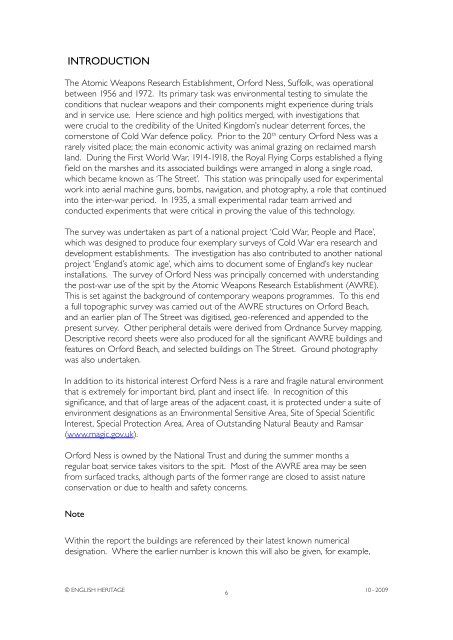Atomic Weapons Research Establishment. Orford ... - English Heritage
Atomic Weapons Research Establishment. Orford ... - English Heritage
Atomic Weapons Research Establishment. Orford ... - English Heritage
Create successful ePaper yourself
Turn your PDF publications into a flip-book with our unique Google optimized e-Paper software.
Introduction<br />
The <strong>Atomic</strong> <strong>Weapons</strong> <strong>Research</strong> <strong>Establishment</strong>, <strong>Orford</strong> Ness, Suffolk, was operational<br />
between 1956 and 1972. Its primary task was environmental testing to simulate the<br />
conditions that nuclear weapons and their components might experience during trials<br />
and in service use. Here science and high politics merged, with investigations that<br />
were crucial to the credibility of the United Kingdom’s nuclear deterrent forces, the<br />
cornerstone of Cold War defence policy. Prior to the 20 th century <strong>Orford</strong> Ness was a<br />
rarely visited place; the main economic activity was animal grazing on reclaimed marsh<br />
land. During the First World War, 1914-1918, the Royal Flying Corps established a flying<br />
field on the marshes and its associated buildings were arranged in along a single road,<br />
which became known as ‘The Street’. This station was principally used for experimental<br />
work into aerial machine guns, bombs, navigation, and photography, a role that continued<br />
into the inter-war period. In 1935, a small experimental radar team arrived and<br />
conducted experiments that were critical in proving the value of this technology.<br />
The survey was undertaken as part of a national project ‘Cold War, People and Place’,<br />
which was designed to produce four exemplary surveys of Cold War era research and<br />
development establishments. The investigation has also contributed to another national<br />
project ‘England’s atomic age’, which aims to document some of England’s key nuclear<br />
installations. The survey of <strong>Orford</strong> Ness was principally concerned with understanding<br />
the post-war use of the spit by the <strong>Atomic</strong> <strong>Weapons</strong> <strong>Research</strong> <strong>Establishment</strong> (AWRE).<br />
This is set against the background of contemporary weapons programmes. To this end<br />
a full topographic survey was carried out of the AWRE structures on <strong>Orford</strong> Beach,<br />
and an earlier plan of The Street was digitised, geo-referenced and appended to the<br />
present survey. Other peripheral details were derived from Ordnance Survey mapping.<br />
Descriptive record sheets were also produced for all the significant AWRE buildings and<br />
features on <strong>Orford</strong> Beach, and selected buildings on The Street. Ground photography<br />
was also undertaken.<br />
In addition to its historical interest <strong>Orford</strong> Ness is a rare and fragile natural environment<br />
that is extremely for important bird, plant and insect life. In recognition of this<br />
significance, and that of large areas of the adjacent coast, it is protected under a suite of<br />
environment designations as an Environmental Sensitive Area, Site of Special Scientific<br />
Interest, Special Protection Area, Area of Outstanding Natural Beauty and Ramsar<br />
(www.magic.gov.uk).<br />
<strong>Orford</strong> Ness is owned by the National Trust and during the summer months a<br />
regular boat service takes visitors to the spit. Most of the AWRE area may be seen<br />
from surfaced tracks, although parts of the former range are closed to assist nature<br />
conservation or due to health and safety concerns.<br />
Note<br />
Within the report the buildings are referenced by their latest known numerical<br />
designation. Where the earlier number is known this will also be given, for example,<br />
© ENGLISH HERITAGE<br />
<br />
10 - 2009

















